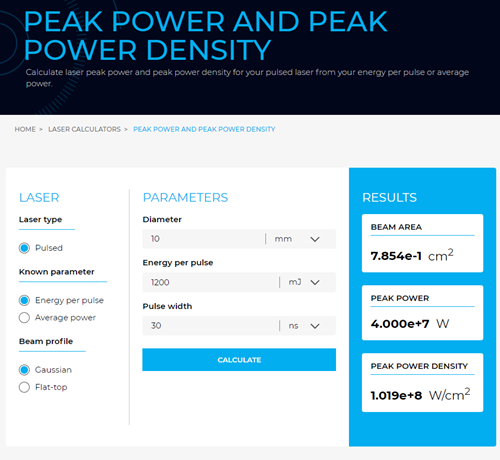Laser peak power vs laser average power
Thursday, February 09, 2023
Thursday, February 09, 2023
Laser output can be classified into 2 large groups: Continuous-wave lasers (CW) and pulsed lasers.
CWs emit a fairly constant stream of light. Average power density is a good metric to understand this type of laser.
Pulsed lasers alternate between emitting no laser light at all and emitting short bursts, called pulses. Average power is not enough to understand what to expect from pulsed lasers. Peak power (and peak density) tells you how powerful the pulses are.
The difference between peak power and average power can be very large. To visualize this, let's use the specs of just one laser, and run it through both the peak power density calculator and the average power density calculator.
The laser we'll use is a 1064 nm YAG laser, emitting 30 ns wide 1200 mJ pulses at a rate of 40Hz. The beam shape at the target will be a gaussian circular profile of 10 mm diameter.


How power is delivered really does matter.
48 W of average power is not that small, but if it is delivered continuously, as a CW does, the target material may have time to dissipate that energy by heating the surrounding material.
As you can see from the results in the screenshot above, the peak power density is about 10^6 (one million) times higher than the average power density! By delivering power in such a concentrated fashion, the target material cannot dissipate the incoming energy fast enough. Instead of a large area heating up near the impact zone, only a very small spot will superheat and be completely vaporized.
Ensure you purchase the most optimal solution for your measurement needs with this checklist. Download it now, it's helpful and free!Buyer's checklist for laser power & energy meters
Having such localized and intense power transfer greatly improves the precision of many processes, including high-end electronics manufacturing and glass cutting & engraving. Additionally, the smaller thermal footprint means it can be used in heat-sensitive environments, like batteries or medical environments.
This does not mean that pulsed lasers are necessarily better for all cases though. High-power applications, often in the industrial sector, may benefit from the generally higher throughput of CWs.
We hope this helps shine a light on the difference between average and peak power. Pun intended!
In the above example, we assumed prior knowledge of the laser's characteristics. In real-world scenarios, you will probably not have that luxury.
Using the laser manufacturer’s spec sheet can give a good first estimate, but for production environments, we definitely recommend using an appropriate power meter to avoid unpleasant surprises or reductions in productivity.
Gentec-EO’s off-the-shelf and custom laser measurement solutions are trusted by thousands, including the folks at Lawrence Livermore National Laboratory, who recently achieved nuclear fusion ignition using our laser beam measurement equipment. Congratulations!